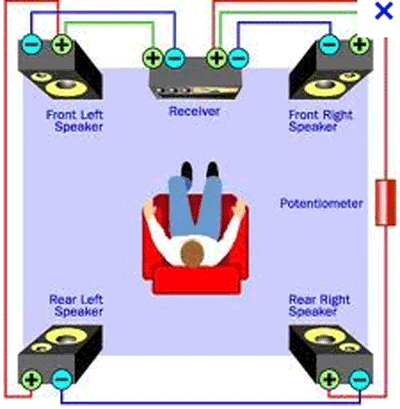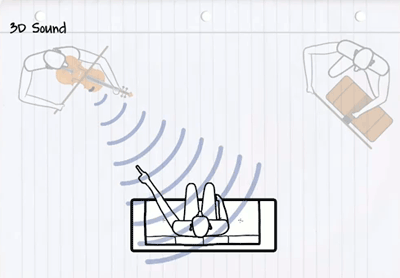Though they have their differences, surround sound and 3D sound are used in very similar ways. Surround sound involves placing multiple speakers around a room to put you in the center of the action. It makes watching movies and television more realistic. With 3D sound, not only do sounds come from the left and right of you, they also come from above and below you. Basically, it turns things up a notch.
What is surround sound?
Throughout the years that television has been in existence, the two biggest changes to enjoying a program or movie is the clarity of the picture and sound. While the former is well documented, not many know how far sound has come.
In movie theaters years ago, the entire soundtrack was played on one speaker, or a collection of speakers that were placed behind the movie screen. Today, audiences in movie theaters are used to hearing sounds thundering on each side of them. What they expect is surround sound. Now that technology, once only enjoyed in movie theaters, is now common in home entertainment centers.

Typical surround sound system set-up at home.
Surround sound, as you know, was invented to change the way viewers watch and listen to entertainment. It uses an array of speakers, placed around a room, to create a multidimensional sonic atmosphere. The idea is to have football games, concerts, and smash-hit movies really come to life.
Surround sound enriches the sound quality of an audio source with additional audio channels from speakers that surround the listener, providing sound from a 360-degree radius. Aside from being immersed in movies and soundtracks in the comfort of your own living room, plenty of other places benefit from surround sound as well, including conferences, video games, and even parks / outdoor attractions where, say, an exhibition at an aquarium is instantly enhanced with the sounds of waves coming to shore.
Surround sound systems have become the standard entertainment equipment when it comes to clear, captivating sound.
What is 3D sound?
As for 3D sound, what is it, exactly? Well, to put it simply, it’s what you’re hearing this very moment. 3D sound, also known as spatial sound, is sound as we hear it naturally, and the technology behind recreating it is quite amazing.
Sounds come from all directions and distances, and we’re able to distinguish them by their pitch, tone, loudness, and location. Let’s say a flock of geese are flying over your house. You can hear them passing by, even though they’re up in the air and outside your house. You know this just from the sounds they make. A car door was shut across the street, but you don’t need to stand up and look down from your apartment window to know that. If someone is coughing behind you in the elevator, you know which direction the sound is coming from without turning your head.
All of these are examples of 3D sound. The spatial location of a sound is what gives it its three-dimensional aspect.
Applications
Taking 3D sound and using it to, say, enhance a user’s experience in a video game, is what has it rivaling one of surround sound’s many uses. Playing a video game with headphones on is where sound in entertainment can have a realistic 3D effect. With headphones on, sound seems to come from the outside world, not from inside the headphones. Because sounds are transferred directly into your auditory canal, without reaching your body, head, and outer ear, it’s possible to replicate true 3D.
With surround sound speakers, the sound is sent to both ears, instead of either the left of the right ear, and the speakers interfere with the clear signal each ear should have. So, based on a player’s whereabouts in a video game, 3D sound can be realistically produced from any direction and can reproduce the sound effects while traveling around obstacles, as long as the listener’s headphones are on.
Here’s a case-in-point example: If your character in a video game is being approached by an enemy from the right side, he or she is able to hear the character coming from that direction. Though surround sound is also capable of producing sounds from different directions, it doesn’t change according to what the listener is doing in a video game.
Feeling like you’re actually in the middle of the action in a completely virtual world and having sound come at you from every which way, is what makes 3D sound more realistic.

3D sound allows us to find the location of the sound source.
Advertisement
Learn more about Electronic Products Magazine





